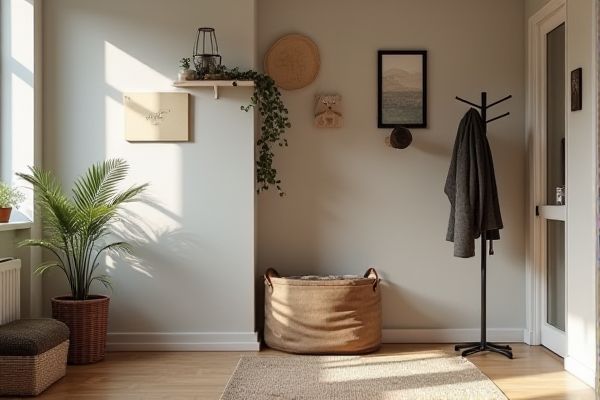
A valet stand offers organized storage for suits, ties, and accessories, keeping your outfit wrinkle-free and ready to wear, while a coat tree primarily focuses on hanging coats and hats, maximizing entryway space. Discover which option best suits Your lifestyle and home by exploring the detailed comparison in the rest of the article.
Table of Comparison
| Feature | Valet Stand | Coat Tree |
|---|---|---|
| Purpose | Organizes clothes and accessories for next-day use | Hangs coats, hats, and outerwear |
| Design | Includes hanger, trouser bar, small trays or compartments | Multiple hooks or branches extending from a central pole |
| Material | Wood, metal, or combinations | Wood, metal, or plastic |
| Typical Location | Bedroom or dressing area | Entryway, foyer, or mudroom |
| Functionality | Keeps suits, ties, belts, and shoes organized and wrinkle-free | Provides quick access and temporary storage for outerwear |
| Size & Footprint | Compact and narrow, minimalist footprint | Usually taller with wider base for stability |
| Style | Elegant, classic, or modern wardrobe accessory | Casual, rustic, or functional decor piece |
Understanding Valet Stands and Coat Trees
Valet stands offer a compact solution designed to organize your suit, tie, and accessories, providing a dedicated space that keeps garments wrinkle-free. Coat trees excel at holding outerwear like coats and hats, often featuring multiple hooks for easy access and display. Choosing between these depends on your storage needs: valet stands prioritize garment care, while coat trees focus on convenience for frequently worn items.
Design and Aesthetic Comparison
A valet stand typically features a structured design with dedicated compartments for garments and accessories, emphasizing functionality combined with sleek, minimalist aesthetics ideal for modern interiors. In contrast, a coat tree boasts a more sculptural, organic form with multiple hooks extending from a central post, offering a casual yet artistic appeal suited for eclectic or traditional spaces. Both options serve as practical storage solutions but differ significantly in visual impact and design intent.
Space Efficiency and Footprint
A valet stand offers a compact and organized solution for storing suits, ties, and accessories, making it ideal for small bedrooms and tight spaces. Coat trees generally require a larger footprint due to their multi-branch design, which can take up more floor space and may not fit well in cramped areas. Choose a valet stand if maximizing your room's space efficiency is a priority while keeping your garments neatly arranged.
Functionality and Utility
Valet stands provide multifunctional utility by combining hanging space for suits and garments with compartments for accessories like watches, wallets, and keys, making them ideal for organized dressing preparation. Coat trees primarily serve as vertical storage for outerwear and hats, offering space-efficient and accessible hanging options but limited in accessory organization. The valet stand's design enhances daily outfit management, while coat trees excel in casual, high-traffic areas for convenient coat storage.
Material and Build Quality
Valet stands often feature sturdy hardwoods like oak, walnut, or maple, providing a durable and polished finish ideal for organizing suits and accessories with long-lasting support. Coat trees typically use lighter materials such as metal or pine, prioritizing mobility and simple functionality but potentially sacrificing some rigidity and wear resistance. Choosing between a valet stand and a coat tree depends on your preference for premium build quality and material strength versus lightweight convenience.
Ease of Assembly and Portability
Valet stands typically require more assembly due to their complex structure with multiple components such as trays, hangers, and shoe racks, making them less portable compared to coat trees. Coat trees offer a simpler design that can be easily assembled and disassembled, enhancing portability and convenience for frequent relocation. Lightweight materials and minimal parts in coat trees contribute to faster setup times and easier transport.
Suitable Room Environments
A valet stand is ideal for bedrooms or dressing rooms, providing organized space for suits, ties, and accessories while keeping outfits wrinkle-free. Coat trees excel in entryways or living rooms, offering a convenient place for guests to hang coats, hats, and scarves. Both pieces complement different room functions by combining practicality with style tailored to specific storage needs.
Price Range and Value
Valet stands typically range from $100 to $500, offering sturdy design and multifunctional use, often including trays and shoe racks for added convenience. Coat trees are generally more affordable, priced between $30 and $150, providing a simple, space-saving solution for hanging coats and hats. Valet stands provide greater value for organized storage and multifunctionality, while coat trees deliver budget-friendly, minimalist coat hanging options.
Maintenance and Durability
Valet stands typically require moderate maintenance due to their mixed materials like wood and metal, which may need occasional polishing and tightening of screws to maintain durability. Coat trees, often crafted from solid wood or metal, usually demand minimal upkeep, focusing mainly on dusting and checking for loose joints to ensure long-lasting stability. Both options offer durable designs, but valet stands may show wear faster due to their multifunctional use and moving parts.
Choosing the Right Option for Your Needs
Valet stands provide multifunctional storage with features like hangers, trays, and shoe racks, ideal for organizing formal wear and accessories in bedrooms or dressing areas. Coat trees offer a more minimalist and space-saving solution for hanging coats, hats, and scarves in entryways or smaller spaces. Selecting between a valet stand and a coat tree depends on your storage needs, available space, and preferred level of organization.
 homyna.com
homyna.com